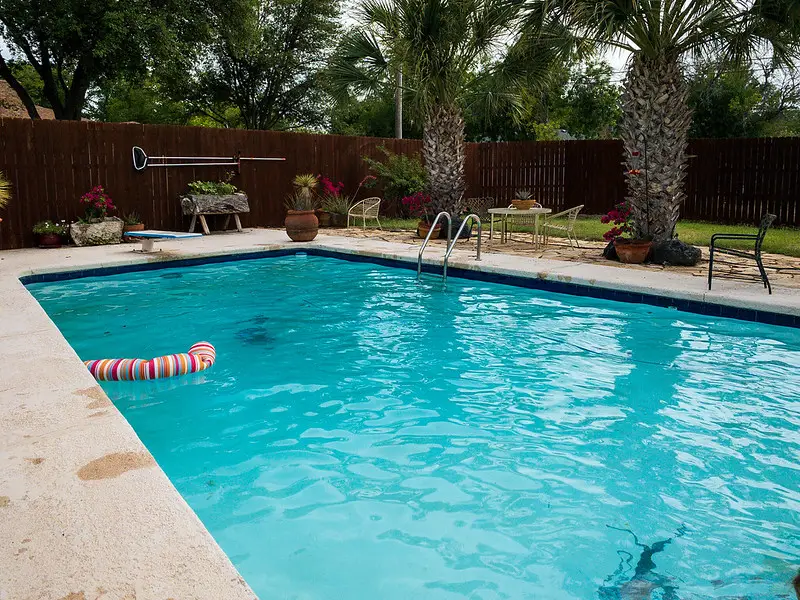You notice your pool water has turned cloudy and, in a panic, you accidentally added too much flocculant in the pool. What happens now?
Under normal circumstances, floc will coagulate with the tiny particles of debris floating in your pool and form heavy clumps that sink to the bottom of the pool to be vacuumed up afterwards.
When you add too much floc into your pool, it will not have a greater effect or work faster, but rather it will probably fail to work effectively or at all. You may notice the floc sticking to itself instead of the debris it is supposed to get rid of. It will form huge clumps and fail to sink to the bottom, making your pool cloudier, and now you have to clean up this new mess as well. Special care needs to be taken to clean it up without damaging the pool filter.
So if you find yourself in that situation, read on to learn how to properly clean up the floc from your pool.
How to deal with too much flocculant in the pool
Under normal circumstances, cleaning up floc is easy – just vacuum up the clumps at the bottom of the pool and you’re done. However, this is a special situation that requires you to take additional steps to clean it up. Here’s how:
Set the pump to off or recirculate
Unlike clarifier, floc is not intended to be removed from circulation via the pool filter. Floc coagulates too much and may clog up or even damage the filter.
For these reasons, you must either shut the pump off or set it to a recirculation setting that bypasses the filter.
Use a net to remove floating clumps
Let’s start with the low hanging fruit, which in this case means to use a net to scoop up any clumps along the surface of the pool.
When too much floc is added, it can stick to itself and form a large clump that fails to sink. Try to scoop up as much as you can to make the next steps easier.
Vacuum the clumps that sank to the bottom
Some of the coagulated floc will sink to the bottom as it is supposed to, however it is unlikely there is much debris in there. However, you must still clean it up. Vacuum your pool to waste, and make sure no floc passes through the filter.
Partially drain and refill the pool
As is often the case when one adds too many chemicals into the pool, a good idea is to partially drain and refill the pool. This can directly get rid of some of the excess chemicals while diluting the rest once new water has been added.
The usual recommendation is to drain and then refill 10% of your pool. So for a 10,000 gallon pool, that means you should drain 1,000 gallons of pool water, and replenish it with 1,000 gallons of new water.
This step can remove some of the excess floc until it reaches a concentration where it will function normally and capture debris as intended.
Remember to keep your pump running on a filter bypass setting as the pool is getting refilled to keep the water circulated. Once you’re done refilling, shut off the pump entirely.
Let the water stand
Now, it is time to let the floc work as intended. Wait for the original amount of time that your floc is supposed to take for it to bond properly to the debris and settle to the bottom. The time may vary slightly between products, as well as the size of your pool and how much debris is in it.
This process can take anywhere from 8-16 hours to as long as 1-2 days. Generally speaking, floc works faster than clarifier.
Clean up the clumps again
It’s time to use the net and vacuum a second time. Only this time, hopefully the floc will be much more effective and there should not be as many clumps floating along the surface.
You should notice an improvement in your pool’s clarity as the floc binds with the particles of debris that made the pool cloudy, and then sinking to the bottom to be vacuumed up.
Once all of the large clumps of floc have been removed, you can finally turn your pool pump back on and resume normal operation.
Pay attention to pressure
It is possible that there are still trace amounts of floc left in the pool that end up in the filter and clog it up. To avoid this scenario, pay attention to the pressure and if you notice a drop, then backwash the filter to rinse the clumps off.
Keep a close eye for at least a few hours after you have finished flocking your pool just in case. If you’ve done a good job, then the filter will have no problems, and you don’t even have to do anything.
You might also be interested in a related topic: what to do when you’ve added too much clarifier in the pool.
Photo credit: Jonathan Cutrer (CC BY 2.0)

